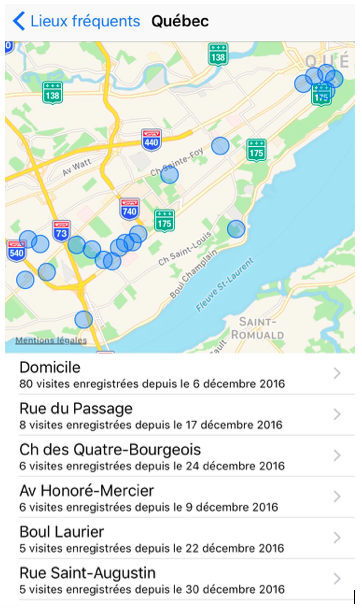On vous suggère aujourd’hui une discussion et une démonstration du fait que l’on est surveillé par la technologie qui se trouve dans nos poches.
Récemment, un débat a eu lieu autour de l’attitude des jeunes du secondaire face au fait que l’on est surveillé partout et en tout temps à cause de la technologie. Selon la journaliste du Devoir Marie-Michèle Sioui, les jeunes n’entretiennent pas du tout le même rapport avec la surveillance que leurs parents et leurs enseignants. Ils s’en foutent même pas mal, apparemment.
Son article, intitulé «1984» ne fait plus peur aux jeunes, a beaucoup fait réagir depuis sa publication dans Le Devoir du 17 décembre 2016. Il a notamment fait sortir de ses gonds le chroniqueur Christian Rioux, qui s’est offusqué de l’inculture qui prévaudrait dans la classe de l’enseignant Jocelyn Lapointe. Une réaction jugée excessive par de nombreux commentateurs.
Faites le test avec vos élèves
Et si on en discutait directement avec les jeunes? Voici quelques pistes.
Demandez-leur d’abord : « Est-ce que vous accepteriez qu’on vous implante un gadget électronique sous la peau qui garderait la trace de partout où vous allez? » C’est une question avec laquelle on pourrait commencer une conversation avec un groupe d’élèves, dans une classe du secondaire, par exemple.
Les réponses obtenues seraient très probablement variées.
On pourrait poursuivre :
— Et croyez-vous que c’est de la science-fiction? Est-ce que cela arrivera pendant votre vie?
— Non? Pourquoi?
Une démonstration stupéfiante
La conversation pourrait se poursuivre avec une démonstration dont l’effet est généralement spectaculaire.
— Est-ce que quelqu’un dans la classe a un iPhone? Est-ce qu’il pourrait me l’apporter et m’y donner accès (le déverrouiller)?
À ce moment, en faisant quelques manipulations très simples qui ne prendront que quelques secondes (voir ci-dessous), il deviendra possible de faire apparaître sur l’écran du iPhone une carte de la région où vous vous trouvez, sur laquelle seront identifiés tous les lieux régulièrement fréquentés par l’élève : son domicile, l’école, la maison de son meilleur ami, peut-être son lieu de travail, etc. Et pour chacun de ces lieux, une liste des dates et de ses heures d’arrivées et de départ au cours des dernières semaines.
Pour la plupart des adultes, c’est une découverte stupéfiante. Et pour plusieurs jeunes aussi, d’ailleurs.
— Alors, vous ne vouliez pas de la puce sous la peau? Et pourtant, vous mettez volontairement votre iPhone dans votre poche tous les matins? Pourquoi donc?
— Saviez-vous que votre iPhone gardait des traces de tous vos déplacements et que je pouvais y avoir accès aussi facilement?
— Pourquoi est-ce que le iPhone conserve ces informations, croyez-vous?
— Désactiverez-vous cette fonction maintenant que vous le savez? Pourquoi?
Semer le début d’une réflexion critique
Marie-Michèle Sioui rapportait dans son article que les élèves de Jocelyn Lapointe lui ont dit l’année dernière : « On est tannés de se faire dire qu’on est surveillés tout le temps. On n’en a rien à foutre. Et si on est heureux comme ça, nous autres? »
L’idée de la conversation proposée n’est donc pas tant de déterminer si cette forme de surveillance est acceptable ou pas. C’est plutôt de semer, à travers et cet exemple très concret, le début d’une réflexion critique sur un phénomène déterminant pour l’évolution de notre société.
Et moi, est-ce que j’ai désactivé cette fonction de localisation sur mon iPhone? Non. Est-ce que je suis sûr que je ne le ferai jamais? Non plus. J’y réfléchis encore…
Et vous, la désactiverez-vous? Pourquoi?
***
COMMENT FAIRE?

- Accéder aux Réglages
- Cliquer sur Confidentialité
- Cliquer sur Service de localisation
- Complètement au bas de la liste, cliquer sur Services système
- Au bas de la première liste d’items, cliquer sur Lieux fréquents
- Dans l’historique, cliquer sur le nom de la ville où vous vous trouvez.
Par exemple, dans mon cas, pour Québec, mon iPhone a identifié 21 emplacements fréquents, et pour chacun d’eux, je peux avoir accès au journal de mes déplacements. Oui, aussi facilement que ça…
Une démonstration semblable peut aussi être faite à partir d’un appareil Android.
* * *
Vous avez tenté l’expérience? N’hésitez pas à nous en parler à l’aide du formulaire de commentaires plus bas sur cette page!




 Recevez l'Info #DevProf et l'Hebdo pour ne rien manquer des nouveautés de l'École branchée!
Recevez l'Info #DevProf et l'Hebdo pour ne rien manquer des nouveautés de l'École branchée!




